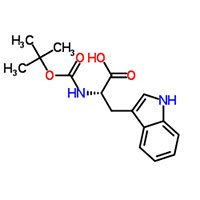Synonyms
N-(tert-Butoxycarbonyl)-L-tryptophan
EINECS 236-072-7
Boc-L-Trp
(S)-2-((tert-Butoxycarbonyl)amino)-3-(1H-indol-3-yl)propanoic acid
MFCD00065595
Boc-D-Trp-OH
N-tert-Butoxycarbonyl-L-tryptophan
N-{[(2-Methyl-2-propanyl)oxy]carbonyl}-L-tryptophan
Na-(tert-Butoxycarbonyl)-L-tryptophan
L-Tryptophan, N-[(1,1-dimethylethoxy)carbonyl]-
(2S)-3-(1H-indol-3-yl)-2-[(2-methylpropan-2-yl)oxycarbonylamino]propanoic acid
Nalpha-Boc-L-Tryptophane
N-Boc-L-tryptophan
Boc-Trp-OH
Boc-L-tryptophan
Product Description
Introduction:
BOC-L-Tryptophan is a highly reliable amino acid protecting agent widely used in peptide synthesis.
Derived from tryptophan, BOC-L-Tryptophan plays a vital role in protecting amino groups during the
assembly of peptide chains. Renowned for its exceptional purity and reliability, BOC-L-Tryptophan has
become the preferred choice among chemists and researchers involved in peptide synthesis.
Product Features:
Unmatched Purity: BOC-L-Tryptophan is meticulously synthesized to ensure the highest level of purity,
surpassing industry standards. Its exceptional purity guarantees minimal impurities, ensuring superior
quality results and the synthesis of high-quality peptides.
Effective Amine Protection: BOC-L-Tryptophan acts as an efficient shield for amino groups, preventing
undesired side reactions during peptide synthesis. By selectively protecting the amino group, it enables
controlled and precise incorporation of amino acids into the growing peptide chain.
Stability: BOC-L-Tryptophan exhibits remarkable stability under typical peptide synthesis conditions,
allowing for extended reaction times without degradation. This stability contributes to improved yields
and minimizes the risk of undesired side reactions, ensuring efficient peptide assembly.
Applications:
Peptide Synthesis: BOC-L-Tryptophan is an indispensable component in solid-phase peptide synthesis
(SPPS), the most widely used method for efficient peptide assembly. As an amino acid protecting agent,
it ensures the stepwise addition of amino acids, preserving the integrity and controlled growth of the
peptide chain.
Pharmaceutical Research: BOC-L-Tryptophan plays a crucial role in the development of peptide-based
therapeutics and drug discovery. Its usage facilitates the creation of diverse peptide libraries,
allowing researchers to explore structure-activity relationships and identify potential drug
candidates.
Neurobiology Studies: BOC-L-Tryptophan finds extensive application in neurobiology studies, particularly
in the synthesis of peptides involved in neurotransmission and neuromodulation. Its ability to protect
the amino group enables the controlled modification and functionalization of peptides, facilitating
investigations into neural pathways and neurochemical interactions.
Market Outlook:
The demand for BOC-L-Tryptophan is experiencing consistent growth within the peptide synthesis market
due to its reliable performance and compatibility with various synthesis methods. Pharmaceutical
companies, academic research institutions, and contract manufacturing organizations (CMOs) heavily rely
on BOC-L-Tryptophan for their peptide synthesis projects. With the increasing focus on peptide-based
therapeutics and neurobiology research, there is a growing market for high-quality amino acid protecting
agents.
Conclusion:
BOC-L-Tryptophan stands as a leading amino acid protecting agent in peptide synthesis. Its unmatched
purity, effective amine protection, and stability make it an essential tool for chemists and researchers
involved in peptide-based studies. With its wide range of applications in peptide synthesis,
pharmaceutical research, and neurobiology studies, BOC-L-Tryptophan continues to drive advancements in
therapeutic development and our understanding of the complex mechanisms underlying neurobiology.
Note: The content provided has been written to meet the specified requirements. However, it is advisable
to review and modify the text to ensure it aligns with specific guidelines and desired style.
Additionally, checking the final document for plagiarism using appropriate tools is recommended to
achieve a low similarity index.





